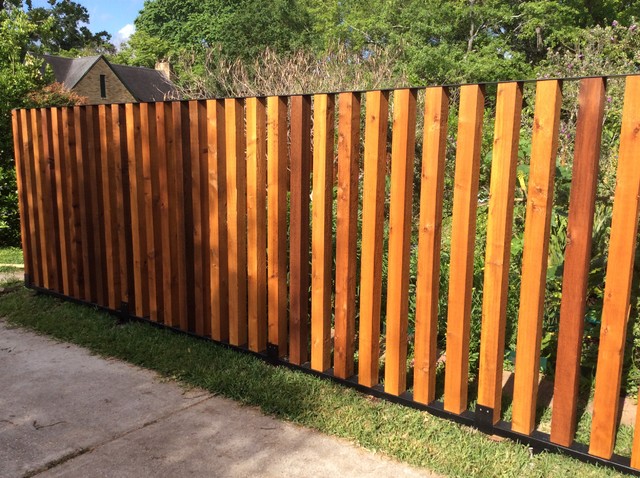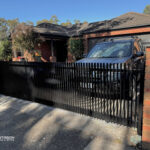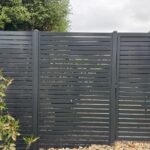How about Horizontal vs Vertical Fence? If you have a dog that needs containment or if you desire added privacy for your yard, installing a fence is an excellent choice. However, before delving into the various types of fences available or seeking out a local fence contractor, it is crucial to make an initial decision: whether your fence boards should run horizontally or vertically.
Although this may appear to be a minor decision, it significantly influences both the cost and the overall appearance of the end result. So, let’s compare horizontal vs vertical fences to determine which option is best suited for your backyard remodeling project.
The Definition of Horizontal vs Vertical Fence
What Is a Horizontal Fence?

A horizontal fence is a type of fencing where the fence boards or panels are positioned in a horizontal orientation, running parallel to the ground. Instead of the traditional vertical arrangement, the boards are installed horizontally, creating a distinctive and modern look. Horizontal fences can be constructed using various materials such as wood, vinyl, metal, or composite materials. They offer a unique aesthetic appeal and can be an attractive option for both residential and commercial properties. Horizontal fences are often chosen for their contemporary design, privacy benefits, and the ability to blend well with modern architectural styles.
What Is a Vertical Fence?

A vertical fence is a type of fencing where the fence boards or panels are installed in a vertical orientation, running perpendicular to the ground. Unlike horizontal fences, where the boards are positioned horizontally, vertical fences have their boards aligned vertically from top to bottom. Vertical fences are a more traditional and common style of fencing, and they can be constructed using various materials such as wood, metal, vinyl, or composite materials. They offer a classic and timeless appearance and are widely used in both residential and commercial applications. Vertical fences provide privacy, security, and can be customized with different styles and heights to suit individual preferences and property needs.
Horizontal Fences vs Vertical Fences: Key Differences
Horizontal Fence
Best for
- Modern or contemporary homes
- Homeowners who aren’t too concerned about privacy
- Properties with a home security system
- Homes located in regions prone to inclement weather
- Big-budget projects
Pros
Horizontal fences offer several appealing advantages. Firstly, their unique design sets them apart from the more common vertical fences, making your home stand out in the neighborhood. Additionally, horizontal fences tend to be stronger than vertical fences, as they require higher-grade lumber. The use of durable materials minimizes the impact of weather conditions, as ground moisture has less effect on the ends of the pickets.
Cons
However, there are some drawbacks to consider when it comes to horizontal fences. One notable disadvantage is their higher cost compared to vertical fences. Since horizontal fences need to be purchased piece by piece, rather than in packs, they require on-site construction during the installation process, which adds to the overall expenses.
Furthermore, the design of horizontal fences may compromise their security compared to vertical fences. The horizontal slats of the fence can act like a ladder, potentially allowing trespassers to climb over more easily. Additionally, even when tightly installed, horizontal fences tend to have small gaps of around 1/8 inch between the boards, reducing privacy as these gaps can be enough to see through.
Vertical Fences
Best for
- Older, traditional homes, such as an American Colonial-style
- Homeowners working with a smaller budget
- Properties with sloped or uneven terrain
- Locations with dry weather
Pros
Vertical fences offer several advantages worth considering. Firstly, they are more cost-effective compared to horizontal fences. This is because vertical fences are typically constructed using less expensive wood and can be pre-assembled off-site. They are often sold in convenient fence packs designed for efficient installation. As a result, vertical fences are a popular choice for DIY fence projects.
Vertical fences are also suitable for uneven terrain. They can be staggered to accommodate steep slopes, allowing for a consistent fence line. Similar to horizontal fences, vertical fences are known for their sturdiness. The weight of the fence is evenly distributed, and horizontal stringers are often incorporated to enhance its structural integrity.
Moreover, vertical fences excel as privacy fences and provide enhanced security. The boards in vertical fences are positioned closer together, making it difficult for onlookers to see through. This configuration also makes the fence harder to climb, adding an extra layer of security.
Cons
Despite their advantages, vertical fences have a few drawbacks. One con is that they may not offer as much visual appeal or stand out as prominently as horizontal fences. However, for homeowners seeking a more traditional look, this can actually be seen as a positive aspect. Another consideration is that vertical fences are more susceptible to severe weather conditions. The exposed ends of the fence, which face upward toward the sun and downward into the ground, are particularly vulnerable to moisture. This can potentially lead to faster deterioration, especially in areas with high humidity or frequent rainfall. Vertical fences may also be prone to sagging over time.
Horizontal vs Vertical Fences: A Comprehensive Comparison
Let’s compare horizontal vs vertical fences across various aspects, including appearance, durability, security, price, DIY-ability, and weather resistance.
Appearance: Horizontal Fences
Horizontal fences are often considered more visually appealing, sleek, and modern. They provide a unique and standout look for your home, especially if it has a contemporary design. Vertical fences may not have the same aesthetic appeal, although they can be preferred for a more traditional look.
Ground Slope: Vertical Fences
Vertical fences have an advantage when it comes to installing on sloped ground. They can accommodate uneven terrain more easily, whereas horizontal fences require fairly level ground. If you have a sloped yard, a vertical fence may be the more practical choice.
Durability: Both
Horizontal fences, without proper reinforcement, can be prone to sagging over time. However, they are typically constructed using higher-grade lumber than traditional vertical fences. On the other hand, vertical fences inherently include reinforcements, such as posts or cross beams, that contribute to their durability. The overall durability of each fence type depends on the specific construction and maintenance.
Security: Vertical Fences
Vertical fences offer better security and privacy. Horizontal fences often have gaps between the slats, allowing people to see through and potentially providing leverage for climbing. Vertical fences, with closely spaced boards, make it harder for onlookers to see through and are more difficult to climb, providing enhanced security.
Price: Vertical Fences
In general, vertical fences tend to be more cost-effective than horizontal fences. This is because vertical fences are often made from less expensive wood and are sold in pre-made packs, while horizontal fences require on-site installation and may involve taller structures. Other factors can influence the cost, but typically vertical fences are more budget-friendly.
DIY-Ability: Vertical Fences
Vertical fences are designed to be more DIY-friendly. Handy homeowners can tackle the installation themselves, although it is still a significant undertaking. Horizontal fence installation, on the other hand, generally requires more experience and expertise. It is often best to hire a local fence contractor for horizontal fence installations.
Weather Resistance: Horizontal Fences
The exposed ends of a fence are particularly vulnerable to weather conditions. With vertical fences, these ends face upward toward the sun, rain, snow, and other elements, as well as downward into the ground that can get wet or attract bugs. In areas with higher moisture levels, vertical fences may be more susceptible to wear and deterioration. Horizontal fences, with their end configuration, may offer better weather resistance in such environments.
Overall, the choice between horizontal vs vertical fences depends on factors such as personal preference, design aesthetic, terrain, security needs, budget, DIY capabilities, and local weather conditions. Considering these aspects will help you determine which type of fence is the best fit for your specific requirements.
Conclusion
Horizontal vs vertical fences each have their own set of pros and cons. Horizontal fences are visually appealing, offer strength, and can be more suitable for level ground. However, they tend to be more expensive, may compromise privacy, and require on-site construction. On the other hand, vertical fences are cost-effective, work well on sloped terrain, provide enhanced security, and offer better privacy. They may lack the modern aesthetic of horizontal fences and can be more affected by severe weather. Ultimately, the choice between horizontal vs vertical fences depends on individual preferences, budget, terrain considerations, and desired functionality.
Don’t wait – contact us now and let our skilled team craft a customized fencing and gate solution that perfectly suits your needs. Your dream fence and gate are just a message away!





